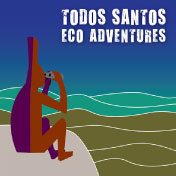By Bryan Jáuregui, Todos Santo Eco Adventures
This article first appeared in Janice Kinne’s Journal del Pacfico.
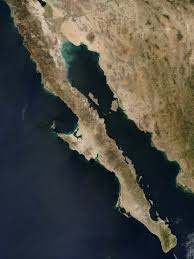
Google Earth Image of the Baja Peninsula
If SmartFish founder Hoyt Peckham has his way, diners in the high-end restaurants of Los Cabos will soon be guaranteed something that may have eluded them for some time–fish caught sustainably in the waters of Baja California Sur.
It seems hard to imagine that restaurants located on a spit of land between two vibrant oceans would have to import fish, but that is exactly what has been happening. Says Drew Deckman, founder and chef of restaurants in Los Cabos and Valle de Guadalupe, “It’s not that there aren’t fantastic fish in the local waters–some of the best seafood in the world is here. The issue is that some methods for catching and processing fish can destroy quality, so sometimes I have to go out with local fishermen myself to ensure that we’re providing our customers with the high quality, sustainably caught fish they deserve. It’s a shame.
Hoyt Peckham describes the problem faced by fishing cooperatives throughout the Baja peninsula. “Many of our local fishing cooperatives are caught in a vicious cycle. They are very good at fishing, but they don’t have the capital or the capacity to bring their fish to market, which puts them at the mercy of aggressive buyers. They end up receiving very poor prices for their fish, so every time they fish they have to make up for the low prices with higher quantities. For example, fishermen at Magdalena Bay sell some of their fish for between 5 and 8 pesos per kilo. By comparison, dirty plastic bottles fetch 9 or 10 pesos per kilo. This means that these fishermen are literally selling their fish for less than garbage, and to break even at that rate they need to catch and sell 800 kilos per day. To make money they need to do 1,000 kilos per day, and there is no way for a small boat to maintain quality at those volumes. This is the reverse alchemy that plagues Baja fishermen: they catch something that could be worth gold, but they’re selling it for less than garbage.”
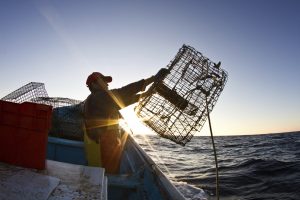
Fishermen baits and sets a trap for sand bass. Photo © Carlos Aguilar – SmartFish
The mission of SmartFish is to reverse that equation and the overfishing that it fuels. Fishing is at the heart of communities throughout Baja, and SmartFish aims to empower local fishermen and their families to rescue the value of their product, while avoiding the predicted extinction of key target species. Says Hoyt, “Here we are on one of the most pristine coasts in North America, fishing every day in the “Aquarium of the World,” but distinguishing customers are importing their fish. We have to reverse that trend.” Otherwise, fears Hoyt, these communities will continue to be marginalized, with a good swath of the social fabric of Baja destroyed in the process.
The current quality problems stem from three main factors: how the fish is caught, how it is stored, and how it is processed.
- How it is caught: Many fishermen use gillnets or traps to catch the volumes they need. These processes produce stress in the fish, which leads to a dramatic increase in blood flow, as well as the excretion of hormones and enzymes. These factors lead to an accelerated degradation of the fish’s flesh when it dies, meaning a much poorer quality of fish reaches the shore. In addition, fish often suffocate in the traps and gillnets, which means they are dead by the time they are brought on board the boat; they have literally started to rot.
- How it is stored: The small fishing pangas of some fishermen have no refrigeration to speak of, so these large volumes of fish are simply dumped in the bottom of the boat where they cook in the hot sun all day. Needless to say, this seriously degrades the quality of the meat. Further, when they reach the shore, in many cases these mounds of fish are just shoveled onto the ground where they continue to cook in the hot sun during processing.
- How it is processed. In some places, the fishermen’s families process the fish at the beach on wooden tables in the sun, and with a large catch, processing can take quite a long while.
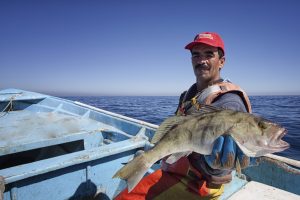
Porfirio Zuñiga displaying a hand-caught sand bass, which he will despatch, bleed and put directly on ice to ensure its freshness Photo © Carlos Aguilar – SmartFish
The SmartFish Difference. Hoyt and his team set out to address these problems by forming a social venture with five fishing cooperatives in Magdalena Bay. The fishermen quickly grasped Hoyt’s vision of higher profitability and sustainability, and Hoyt helped them gain access to funding for the equipment and training they needed to make the vision a reality. The fishermen successfully switched from their high volume, high bycatch gillnetting and trapping techniques to much smaller volume / no bycatch hook and line fishing and eco-traps that have escape hatches for smaller fish and barriers to larger fish. All fish are brought in alive by hand, quickly dispatched and bled, then immediately put into ice water, maintained below 4C.
“This process generates fish that is dramatically different in quality, and the high-end chefs have really been blown away.” Says Drew Deckman “Not only are we willing to pay a premium for the superb quality of fish coming out of SmartFish, we’re willing to pay a premium for the sustainability that is inherent to this process. This is a major win for both the fishermen and the restaurants they serve in Baja.” One of Smartfish’s first customers was El Bismarkcito, a much-loved seafood restaurant in La Paz. The owner, who has been selling seafood under the same trees along the Malecón for decades, at first refused to believe that the fish was one of the species she had bought for years. When finally convinced, the only question she had was, “Can you get me more?”
For SmartFish the challenge now is not demand but supply. The success of the pilot cooperatives is generating considerable interest, but not even all the boats in the those cooperatives have been converted; it takes at least one year to get a fleet up to the SmartFish standard. With a relatively small number of boats in the program, Hoyt currently can personally guarantee that the fish bought by El Bismarkcito or Drew has been caught responsibly. But soon that will change as the number of fisherman in the system increases. To address this issue SmartFish is launching a process of traceability using the technology and techniques of ShellCatch (www.shellcatch.com) in which consumers can track a fish from the fisherman’s hook to their own plates.
Hoyt characterizes all this as SmartFish’s “Value Rescue formula” and is excited that it is yielding “impressive triple-bottom-line outcomes”: 1. Economic
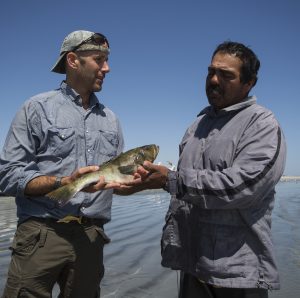
Fisherman Francisco Rodríguez Romero details with pride the quality of his sand bass to Hoyt Peckham Photo © Carlos Aguilar – SmartFish
outcome: fishermen are realizing important price increases, usually exceeding 100%; 2. Power outcomes: Fishermen and their families are taking control of their economic destinies as price setters, and chefs and other retailers are able to offer sustainable and high quality seafood; and 3. Environmental outcomes: there is a 40-60% lower catch volume than the status quo for target species; there are minimum and in some cases maximum size limits; there is decreased fish bycatch and zero megafauna bycatch (no turtles, dolphins etc. killed in gillnets); and a switch to more resilient target populations, i.e. away from grouper and shark towards sand bass and yellowtail.
Drew Deckman is sold. “I’m the governor of Slow Food for the entire Baja peninsula and the vertical integration that Hoyt is seeking in the fishing cooperatives is exactly what I look for in every new location in which I establish operations. Before I was a chef I was a commercial fisherman and a master diver, so for me the SmartFish solution is ideal; it is the logical conclusion of all my efforts. It’s fantastic to work with Hoyt and the cooperatives, and we’re all excited about the change this will bring to the lives of fishermen in Baja.” SmartFish, smart choice.
For more information on SmartFish you can visit their website at http://smartfish.mx/
It’s Not all Dire Straits in BCS
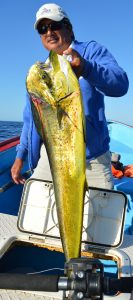
Todos Santos Fisherman Agustin Agundez
Of course not all fishing cooperatives in Baja are subject to the same forces Hoyt describes. Many receive good prices for their fish and have catching and processing techniques that deliver a high quality product to consumers. In Todos Santos, for example, fishermen Agustin Agundez reports that they receive 60 pesos per kilo for desirable fish like cabrilla and huachinango. While some Todos Santos fishermen do use gillnetting, they also fish with hook and line to ensure that local restaurants have the great quality fish for which they are rightfully famous. Chef Dany Lamote of Santo Vino has a great working relationship with the local fishermen. “The fishing cooperatives in Todos Santos know the quality that Santo Vino demands and we are very pleased with the fish we get here. We often buy the fish right off the boat and it is still very cool and very fresh.”
